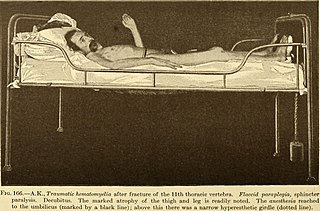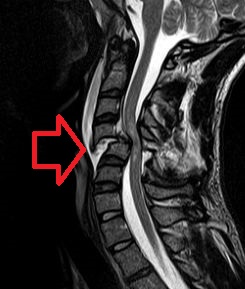Hemiparesis, or unilateral paresis, is weakness of one entire side of the body. Hemiplegia is, in its most severe form, complete paralysis of half of the body. Hemiparesis and hemiplegia can be caused by different medical conditions, including congenital causes, trauma, tumors, or stroke.
Spasticity is a feature of altered skeletal muscle performance with a combination of paralysis, increased tendon reflex activity, and hypertonia. It is also colloquially referred to as an unusual "tightness", stiffness, or "pull" of muscles.
Activities of daily living is a term used in healthcare to refer to people's daily self-care activities. Health professionals often use a person's ability or inability to perform ADLs as a measurement of their functional status. The concept of ADLs was originally proposed in the 1950s by Sidney Katz and his team at the Benjamin Rose Hospital in Cleveland, Ohio. The concept of ADLs has been added to and refined by a variety of researchers since that time. For example, many indexes that assess ADLs now include some measure of mobility. Additionally, to be more inclusive of the range of activities that support independent living, in 1969, Lawton and Brody developed the instrumental activities of daily living (IADLs). ADLs are often used in the care of people with disabilities, people with injuries, and the elderly. Younger children often require help from adults to perform ADLs, as they have not yet developed the skills necessary to perform them independently.
Rehabilitation of sensory and cognitive function typically involves methods for retraining neural pathways or training new neural pathways to regain or improve neurocognitive functioning that have been diminished by disease or trauma. The main objective outcome for rehabilitation is to assist in regaining physical abilities and improving performance. Three common neuropsychological problems treatable with rehabilitation are attention deficit/hyperactivity disorder (ADHD), concussion, and spinal cord injury. Rehabilitation research and practices are a fertile area for clinical neuropsychologists, rehabilitation psychologists, and others.

Paraplegia is an impairment in motor or sensory function of the lower extremities. The word comes from Ionic Greek (παραπληγίη) "half-stricken". It is usually caused by spinal cord injury or a congenital condition that affects the neural (brain) elements of the spinal canal. The area of the spinal canal that is affected in paraplegia is either the thoracic, lumbar, or sacral regions. If four limbs are affected by paralysis, tetraplegia or quadriplegia is the correct term. If only one limb is affected, the correct term is monoplegia. Spastic paraplegia is a form of paraplegia defined by spasticity of the affected muscles, rather than flaccid paralysis.

Sir Ludwig Guttmann was a German-British neurologist who established the Stoke Mandeville Games, the sporting event for people with disabilities (PWD) that evolved in England into the Paralympic Games. A Jewish doctor who fled Nazi Germany just before the start of the Second World War, Guttmann was a founding father of organized physical activities for people with disabilities.

A spinal cord injury (SCI) is damage to the spinal cord that causes temporary or permanent changes in its function. Symptoms may include loss of muscle function, sensation, or autonomic function in the parts of the body served by the spinal cord below the level of the injury. Injury can occur at any level of the spinal cord and can be complete, with a total loss of sensation and muscle function at lower sacral segments, or incomplete, meaning some nervous signals are able to travel past the injured area of the cord up to the Sacral S4-5 spinal cord segments. Depending on the location and severity of damage, the symptoms vary, from numbness to paralysis, including bowel or bladder incontinence. Long term outcomes also range widely, from full recovery to permanent tetraplegia or paraplegia. Complications can include muscle atrophy, loss of voluntary motor control, spasticity, pressure sores, infections, and breathing problems.

Physical medicine and rehabilitation, also known as physiatry, is a branch of medicine that aims to enhance and restore functional ability and quality of life to people with physical impairments or disabilities. This can include conditions such as spinal cord injuries, brain injuries, strokes, as well as pain or disability due to muscle, ligament or nerve damage. A physician having completed training in this field may be referred to as a physiatrist.

A standing frame is assistive technology that can be used by a person who relies on a wheelchair for mobility. A standing frame provides alternative positioning to sitting in a wheelchair by supporting the person in the standing position.
Autonomic dysreflexia (AD) is a potential medical emergency classically characterized by uncontrolled hypertension and bradycardia, although tachycardia is known to commonly occur. AD occurs most often in individuals with spinal cord injuries with lesions at or above the T6 spinal cord level, although it has been reported in patients with lesions as low as T10. Guillain–Barré syndrome may also cause Autonomic Dysreflexia.
A patient-reported outcome (PRO) is a health outcome directly reported by the patient who experienced it. It stands in contrast to an outcome reported by someone else, such as a physician-reported outcome, a nurse-reported outcome, and so on. PRO methods, such as questionnaires, are used in clinical trials or other clinical settings, to help better understand a treatment's efficacy or effectiveness. The use of digitized PROs, or electronic patient-reported outcomes (ePROs), is on the rise in today's health research setting.

Wheelchair racing is the racing of wheelchairs in track and road races. Wheelchair racing is open to athletes with any qualifying type of disability, amputees, spinal cord injuries, cerebral palsy and partially sighted. Athletes are classified in accordance with the nature and severity of their disability or combinations of disabilities. Like running, it can take place on a track or as a road race. The main competitions take place at the Summer Paralympics which wheelchair racing and athletics has been a part of since 1960. Competitors compete in specialized wheelchairs which allow the athletes to reach speeds of 30 km/h (18.6 mph) or more. It is one of the most prominent forms of Paralympic athletics.
Neurorehabilitation is a complex medical process which aims to aid recovery from a nervous system injury, and to minimize and/or compensate for any functional alterations resulting from it.
Stephen Thomas Wegener is an American rehabilitation psychologist specializing in the psychology of pain management. His work seeks to improve function and reduce disability for persons with chronic illness and impairments, including occupational injuries, rheumatic disease, spinal cord injury or limb loss. He also develops cognitive-behavioral therapy and self-management to prevent or mitigate pain associated with disability, and examines psychological variables that can affect positive outcomes.
When treating a person with a spinal cord injury, repairing the damage created by injury is the ultimate goal. By using a variety of treatments, greater improvements are achieved, and, therefore, treatment should not be limited to one method. Furthermore, increasing activity will increase his/her chances of recovery.

Although spinal cord injury (SCI) often causes sexual dysfunction, many people with SCI are able to have satisfying sex lives. Physical limitations acquired from SCI affect sexual function and sexuality in broader areas, which in turn has important effects on quality of life. Damage to the spinal cord impairs its ability to transmit messages between the brain and parts of the body below the level of the lesion. This results in lost or reduced sensation and muscle motion, and affects orgasm, erection, ejaculation, and vaginal lubrication. More indirect causes of sexual dysfunction include pain, weakness, and side effects of medications. Psycho-social causes include depression and altered self-image. Many people with SCI have satisfying sex lives, and many experience sexual arousal and orgasm. People with SCI employ a variety of adaptations to help carry on their sex lives healthily, by focusing on different areas of the body and types of sexual acts. Neural plasticity may account for increases in sensitivity in parts of the body that have not lost sensation, so people often find newly sensitive erotic areas of the skin in erogenous zones or near borders between areas of preserved and lost sensation.
The Modified Overt Aggression Scale (MOAS) is a four-part behavior rating scale used to evaluate and document the “frequency and severity” of aggressive episodes. The rating scale is made up of four categories; verbal aggression, aggression against objects, aggression against self, and aggression against others. Each category consists of five responses, which over time can track the patient's aggressive behavior. The MOAS is one of the most widely used measures for violence and aggression.
The Functional Independence Measure (FIM) is an assessment tool that aims to evaluate the functional status of patients throughout the rehabilitation process following a stroke, traumatic brain injury, spinal cord injury or cancer. Its area of use can include skilled nursing facilities and hospitals aimed at acute, sub-acute and rehabilitation care. Performed on admission to and departure from a rehabilitation hospital, it serves as a consistent data collection tool for the comparison of rehabilitation outcomes across the health care continuum. Furthermore, it aims to allow clinicians to track changes in the functional status of patients from the onset of rehab care through discharge and follow-up. The FIM's assessment of degree of disability depends on the patient's score in 18 categories, focusing on motor and cognitive function. Each category or item is rated on a 7-point scale. As such, FIM scores may be interpreted to indicate level of independence or level of burden of care. The scale is used to assess how well a person can carry out basic activities of daily living and thus how dependent he or she will be on help from others. Other areas assessed include the physical like how well patients move and walk, and the cognitive, how well they interact with others, communicate, and process information. FIM was originally made for people who had had strokes, but is used to assess disability in other cases as well.
The PHQ-9 is a 9-question instrument given to patients in a primary care setting to screen for the presence and severity of depression. It is the 9-question depression scale from the Patient Health Questionnaire (PHQ). The results of the PHQ-9 may be used to make a depression diagnosis according to DSM-IV criteria and takes less than 3 minutes to complete. The total of all 9 responses from the PHQ-9 aims to predict the presence and severity of depression. Primary care providers frequently use the PHQ-9 to screen for depression in patients.
Milos R. Popovic is a scientist specializing in Functional Electrical Stimulation (FES) and neurorehabilitation. As of 2018, he is Director of the KITE Research Institute at UHN Toronto Rehabilitation Institute (TRI), and a Professor with the Institute of Biomaterials and Biomedical Engineering at the University of Toronto.







